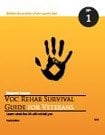Part 1 of 4
Starting your VA claim for disability compensation
I’ll start by explaining what I did and why it was wrong to help other disabled veterans NOT do what I did. Consider this a case of do what I say, not what I did. It is important to not repeat the following because it will cause a lengthy appeal process – and there is nothing worse than a 10-year appeal process. It’s like waiting for your IRS tax refund, except its more money and, like Rip Van Winkle, I look a whole lot older.
Don’t be dumb. I hand wrote my initial application for compensation without reviewing my Service Medical Records (SMRs). My claim led with the statement: “see supporting medical documentation in my file.” This was dumb. Imagine someone sending you a hand written, 300-page manuscript (doctor’s scribbles plus my own) and allowed you 4 hours to read it. Then they ask you a ton of questions that are legally binding. That is what I asked the VA to do 10 years ago. In reality, the VA adjudication process is very complex and time consuming for the veteran and the VA. Do not expect the VA to connect the dots. This is your job if you choose to take it, or you’ll be older and fatter still fighting the good fight, like me.
Get started. For veterans with copies of their SMRs, get moving. Any condition diagnosed within one year of separation could be considered service connected, even if it was undiagnosed in service. For those without the records, request a copy of your SMR’s from your local regional office. Mail in a Freedom of Information Act (FOIA) request. Click here to find a sample FOIA letter. Once you have the chance to review the documents, you can begin your own research.
Research every condition and injury you have within your medical records (about the possible presumptive conditions that show up within one year – bring these up too). To do this, identify the key terms and find them in 38 CFR Part 4: Schedule of Ratings. For example, let’s say you have Sinusitis. Within your records, you can document 5 different occasions that you went to the doctor for the condition (like allergies, congestion, etc). Go to the CFR and find Sinusitis. A quick way to do this is to click [Control + F] and type in Sinusitis. This should lead you right to the rating criteria. Notice for the condition, the requirements “either or” tendency. Here, you either have periods of incapacitation or you have “non-incapacitating” episodes. Decide where you currently fall into the rating schedule. Then, you can Google the condition on either regular Google or Google Scholar. Read about what Sinusitis actually is and what causes it. Get educated on each and every condition you are claiming this same way.
Write up a summary of all the conditions and include dates of treatment while in service and after. You do not need to seek medical attention for every issue in order to document it. For example, incapacitating episodes are considered episodes that required a doctor’s visit. Non-incapacitating episodes are not. A person can self-medicate certain conditions. But always remember, the condition needs to be current in order to count. If it stopped hurting last year, then you will likely not get a rating for it.
Come to www.disabledveterans.org to read the rest on the topic, soup to nuts.
# # # # #
 Benjamin Krause is an award winning investigative journalist, attorney, and disabled veteran of the US Air Force, where he served in its Special Operations Command. He wrote his guide, the Voc Rehab Survival Guide for Veterans, after winning his long fight for benefits against VA to help other veterans do the same. Benjamin is a graduate of Northwestern University and the University of Minnesota Law School using VA Vocational Rehabilitation.
Benjamin Krause is an award winning investigative journalist, attorney, and disabled veteran of the US Air Force, where he served in its Special Operations Command. He wrote his guide, the Voc Rehab Survival Guide for Veterans, after winning his long fight for benefits against VA to help other veterans do the same. Benjamin is a graduate of Northwestern University and the University of Minnesota Law School using VA Vocational Rehabilitation.



